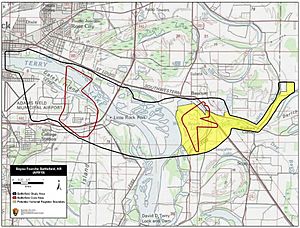Battle of Bayou Fourche facts for kids
Quick facts for kids Battle of Bayou Fourche |
|||||||
|---|---|---|---|---|---|---|---|
| Part of the Trans-Mississippi Theater of the American Civil War |
|||||||
 Bayou Fourche Battlefield |
|||||||
|
|||||||
| Belligerents | |||||||
| Commanders and leaders | |||||||
|
|
|
||||||
| Units involved | |||||||
| "Arkansas expedition" | District of Arkansas | ||||||
| Strength | |||||||
| 15,000, 49 guns |
7,749, 32 guns |
||||||
| Casualties and losses | |||||||
| 18 dead, 119 wounded or missing |
12 dead, 52 wounded or missing |
||||||
The Battle of Bayou Fourche, also known as the Battle of Little Rock and the Engagement at Bayou Fourche, took place on September 10, 1863, in Pulaski County, Arkansas, and was the final battle of the Little Rock Campaign, also known as the Advance upon Little Rock, which began on August 1 to capture the capital. Union Major-General Frederick Steele's "Arkansas expedition," 15,000 strong, defeated Confederate Major-General Sterling Price's 7,749 District of Arkansas. The Confederate forces took up defensive positions in and around the city of Little Rock. The area of the battle was bisected by the Arkansas River, with the Bayou Fourche forming an additional obstacle to the south-east of Little Rock. Steele divided his army into two main sections in order to attack from both the east and south-east. There was fierce fighting at river crossing points and, following the crossing of the Bayou Fourche to the east of the city, the "Arkansas expedition" entered Little Rock and organized Confederate resistance collapsed. Price's army was able to escape capture.
Background
On July 4, 1863, Vicksburg, Mississippi – the Gibraltar of the Confederacy – fell. With the Mississippi River again, in President Abraham Lincoln's words, running "unvexed to the sea," Steele, commanding the "Arkansas Expedition," preceded from Helena on August 10 to lead the invasion of 12,000 troops west into Arkansas. Awakening to the distant rumble of artillery September 10, the citizens of Little Rock found themselves in the vortex of the conflict.
Battle
On September 10, 1863, Steele sent a cavalry division led by Brigadier-General John W. Davidson across the Arkansas River to advance on Little Rock while he moved against Confederate forces strongly entrenched on the north side of the river. In his thrust toward the state capitol, Gen. Davidson ran into Marmaduke and Walker's divisions commanded by Brigadier-General John S. Marmaduke near the Bayou Fourche. Aided by field artillery from the north side of the river, Davidson forced Marmaduke out of his position and sent the defenders fleeing back to Little Rock, which fell to U.S. forces that evening.
Aftermath
C.S. Army Major-General Sterling Price, commanding at Little Rock, fell back to Arkadelphia on the 14th, and eventually reestablished his command at Camp Bragg, Arkansas. Governor Harris Flanagin relocated the state capitol to Washington, Arkansas, where it remained for the rest of the war. The fall of Little Rock to Union forces after Vicksburg, sealed Arkansas' fate and helped to further demoralize Confederate citizens west of the Mississippi River.
Battlefield preservation
The growth of Little Rock has obscured many of the sites associated with the battle and subsequent evacuation of the city. Today, several markers and monuments are located inside the Bayou Fourche Battlefield, but further expansion of Little Rock National Airport threatens to consume additional land.
See also

